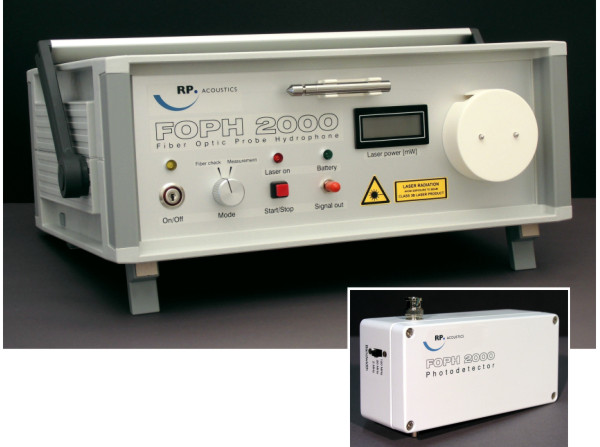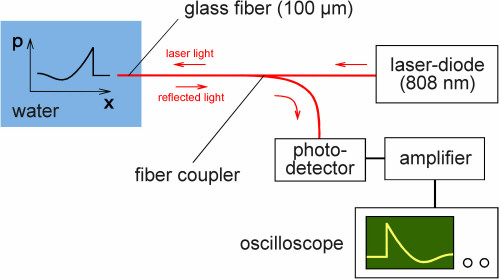| High precision measurements |
| Measurement services | Fiber Optic Probe Hydrophone
FOPH 2000 |
PVDF hydrophones |
Fiber Optic Probe Hydrophone FOPH 2000
We offer measurement services with the Fiber Optic Probe Hydrophone FOPH 2000. The FOPH 2000 is the ideal instrument for the absolute measurement of short time high positive and negative pressures in liquids. It is used by numerous metrological, medical and scientific laboratories worldwide for reliable soundfield characterizations.
The sensitive element for measuring pressure is the tip of an optical glass fiber. The pressure signal is detected via the changing light reflection at the glass fiber/water interface caused by the pressure/density influence on the refractive index of water.
Due to the fact that the refractive index of a liquid depends on pressure and temperature the FOPH 2000 can also be used as a temperature measuring instrument with high spatial and temporal resolution (interesting for HIFU applications).

Main device and photodetector of the Fiber Optic Probe Hydrophone FOPH 2000
Properties
- Simple and quick calibration without reference standards. Because of the self-calibration, the Fiber Optic Probe Hydrophone can be used as a measuring standard itself.
- High spatial resolution: 100 µm.
- Bandwidth 0 to 2/20/100 MHz, adjustable (up to 150 MHz with deconvolution of hydrophone properties).
- Risetime 3 ns, electronically limited.
- Theoretical bandwidth: 0 to 3 GHz.
- Because of the hydrophone's small diameter, a directivity dependence of the sensitivity can only be noticed for frequencies higher than 1 MHz.
- Complete and repeatable reproduction of positive and negative pressure amplitudes.
- Since the adhesion between water and the glass fiber exceeds the cohesion of water, a detachment of the water contact is avoided even at high negative pressures . The occasional loss of the water contact by cavitation nuclei at the fiber tip leads to an anomal increase of reflected laser light and can be clearly identified in the measurement.
- Equipped with 20 m measuring glass fiber.
- A damaged glass fiber tip can easily be repaired within a few minutes.
- Because of the optical principle of measurement, there is an extreme insensitiveness to electromagnetic interference.
- Battery operation of the device prevents electromagnetic interferences via mains cables.
Applications
Numerous possible applications exist in the medical field, in general ultrasonic calibration and measurement as well as in the characterization of technical ultrasonic equipment:
- Absolute measurements of high positive and negative pressures in liquids.
- Pressure measurements in the focus and the extended wave field of medical instruments for extracorporal shock wave lithotripsy (destruction of kidney and gallstones) according to IEC 61846.
- Pressure measurements in the extended wave field of non-focusing or weakly focusing extracorporal therapy devices (treatment of tennis elbow, heel spur etc.) according to IEC 63045.
- Pressure and temperature measurements in the focus and the extended wave field of medical instruments for extracorporal ultrasound cancer therapy (high intensity focused ultrasound, HIFU).
- Pressure and temperature measurements in the focus and the extended wave field of ultrasonic instruments for medical diagnosis.
- Characterization and certification of medical instruments for diagnosis and therapy (IEC 61157).
- Examination of the wave field of ultrasound cleaning devices.
Operation principle

Operation principle of the Fiber Optic Probe Hydrophone
Pressure waves in liquids cause changes of mass density which modulate the optical refractive index. With the Fiber Optic Probe Hydrophone the change of the refractive index can be measured by the light reflection at the tip of a glass fiber submerged in a liquid.
Laser light is coupled into the rear end of the glass fiber and is partly transmitted through and partly reflected at the fiber tip.
For a short time, a pressure wave changes the density and the refractive index of the liquid, so that the intensity of the reflected light is modulated.
The reflected light is coupled by an optical fiber coupler to a fast semiconductor-photodetector and is converted to an electric signal which reproduces, after being amplified, the pressure time curve on the oscilloscope screen.
With respect to the stationary light reflection signal, the simple calibration instruction allows the determination of the relation between pressure and photodiode signal.
Summary of the technical data
| Spatial Resolution |
100 µm |
| Risetime |
3 ns |
| Bandwidth |
DC to 150 MHz |
| Single pulse pressure
resolution |
+/- 0.7 MPa |
| Sensitivity |
2 mV/MPa |
| Measuring range acoustical pressure (tested) |
-60 MPa to 400 MPa |
| Measuring range water temperature (tested) |
5 °C to 95 °C |
| Accuracy |
+/- 5 % |
| Measuring glass fiber
length |
20 m |
| RP acoustics 2025 |
Contact |
Legal notice |
Privacy |